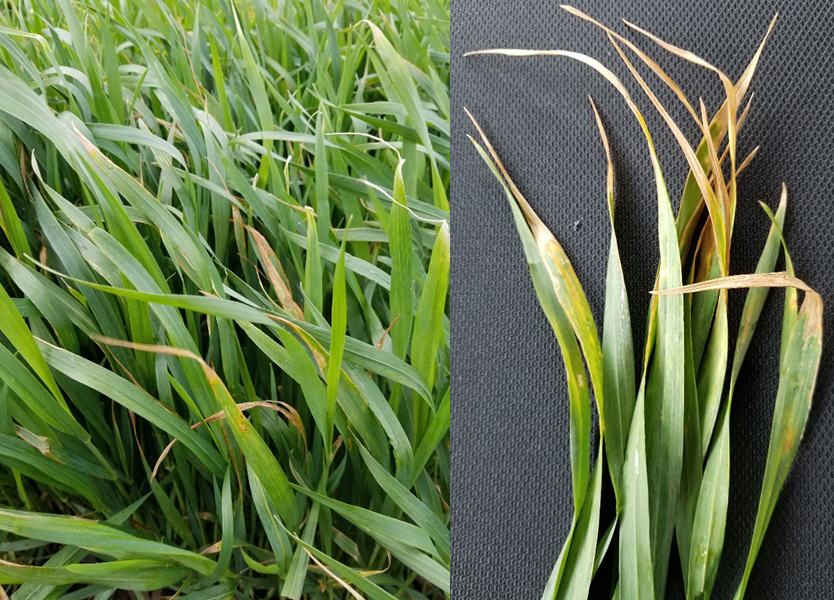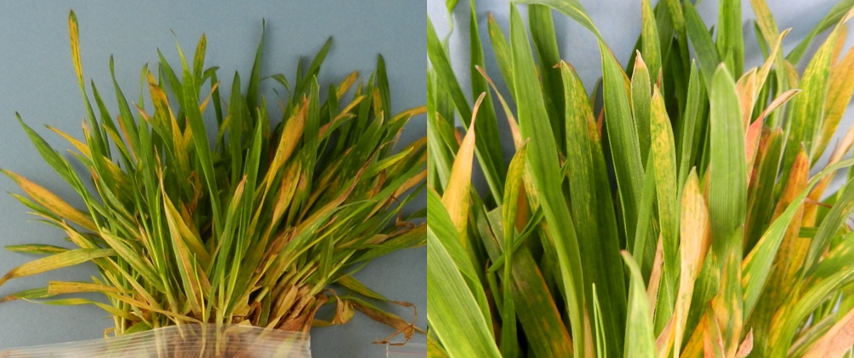Wheat has greened up and is actively growing across Indiana (except during these last few cold spells). Our southern field plots in Vincennes were at Feekes 10.3-10.4 (1/4 to 1/2 head visible) this week, while in West Lafayette plots are at Feekes 8 (last leaf visible). There have been some concerns about fields with yellow-necrotic leaves and yellow stunted patches of plants. A variety of factors can contribute to these symptoms including several wheat virus pathogens as well as soil pH, fertility, and environmental factors. It is important to observe the whole field to determine the special distribution of symptoms – are they uniform, spotty, or patterned in appearance? Are they in a low, wet area or are they along a field edge where insect vectors are moving off overwintering hosts.
There have been a number of freezing periods this spring as wheat was beginning to green up. Cold stress can lead to a number of symptoms in wheat depending on the growth stage in which the conditions occur. The freezing weather may cause the tips of young leaves to become yellow or necrotic in a uniform pattern across the field (Fig. 1). Culm damage may occur if the freeze occurs during stem elongation, this may cause the damaged area to appear discolored – bleached, soft and water-soaked (Fig. 2). The damage may also disrupt vascular tissue and lead to lodging. As we are approaching the boot and head stages in Indiana a hard freeze also has the potential to damage the spike and interfere with reproduction and grain fill. We will continue to keep a close eye on our wheat as more cold conditions are in the forecast.

Figure 1. Uniform distribution of leaf tip burn – low temperature injury. (Photo Credit: Darcy Telenko)
Wheat Virus Identification
There are four common viruses that cause disease in Indiana wheat. They include five strains of barley yellow dwarf virus (BYDV), wheat spindle streak mosaic virus (WSSMV), soilborne wheat mosaic virus (SBWMV), and wheat streak mosaic virus (WSMV).
You can potentially identify wheat virus identification based on symptoms in the field. However lab testing is essential for accurate diagnosis. Typically, virus infected plants appear as uneven patches of yellow to light green areas in a field, but this can easily be confused with environmental/site issues including low pH and related nutritional deficiencies.
Symptoms of wheat spindle streak mosaic virus (WSSMV) and soilborne wheat mosaic virus (SBWMV) are visible in the spring and are generally uniform across a section of the field. A yellow/green mottled, mosaic pattern will be visible on the leaves. The plants may be stunted with leaf tip dieback and lower leaves may have a reddish appearance. Plants infected by WSSMV or SBWMV may have fewer tillers, stems and heads with fewer kernels. Infection occurs in the fall. The viruses are transmitted to the wheat root by a soilborne fungus vector, Polymyxa graminis, and can survive in the soil for up to five years.
Symptoms caused by wheat streak mosaic virus (WSMV) on wheat growing in Indiana may include yellowing, stunting, and curling of leaves due to feeding by the wheat curl mite, the primary vector of WSMV (Fig. 3). Time of infection and environmental conditions will determine severity of disease; warm, dry conditions favor WSMV due to an increase in the wheat curl mite population. Wheat curl mites can transmit the virus for up to a week after feeding on an infected plant and generally move in the wind from one plant to another in a field. Early colonization of the wheat by the wheat curl mite can lead to a more pronounced WSMV symptom development, premature plant death, and greater yield loss.

Figure 3. Wheat infected by wheat spindle streak mosaic virus (WSSMV). Typical display of spindle-like chlorotic lesions of WSSMV on foliage and mosaic pattern. Yellow, mottled, mosaic patterns can also be a symptom of SBWMV infection.
Barley yellow dwarf virus (BYDV) has many different strains that can infect more than 150 different grass species, including wheat, oats, barley, rice, and corn. These viruses are vectored by aphids. Once an aphid acquires the virus by feeding on an infected host it can transmit the virus to a new host for two to three weeks. It will take two to three weeks for symptoms to appear in wheat after the initial infection while fall infections may not appear until the following spring. Symptoms of BYDV in wheat include stunted tillers and roots and discolored foliage. A reddish discoloration usually starts at the tip of the flag leaf and moves downward; eventually in wheat the leaves may appear yellow, red, or purple in color. BYDV infection can lead to reduced tillering, poor flowering and kernel sterility or failure to fill.
Management Options for Wheat Viruses
There are no control options to reduce viral symptoms in currently infected plants. However, accurate diagnosis of wheat viruses is important for future disease management plans. Healthy plants can better tolerate infection, so it is important to manage other foliar diseases in wheat and maintain adequate moisture and nutrients.
Many wheat varieties are available that have partial resistances to one or more of these wheat viruses and/or their vectors. Understanding a field’s risk for a specific virus can aid in variety selection down the road, as planting a less susceptible variety is the first line of defense in viral disease management.
Removal of volunteer wheat or other grasses late in the season may also help reduce the “green bridge” for the vectors or virus survival into the next season.
If you suspect viral infection, a sample can be submitted to the Purdue Plant and Pest Diagnostic Lab (PPDL) (https://ag.purdue.edu/btny/ppdl/Pages/Submit-A-Sample.aspx). The PPDL can test for the presence of ten wheat viruses. They include five strains of barley yellow dwarf virus (BYDV; strains PAV, MAV, RMV, SGV, and RPV); wheat spindle streak mosaic virus (WSSMV); soilborne wheat mosaic virus (SBWMV); wheat streak mosaic virus (WSMV); high plains virus (HPV) and Triticum mosaic virus (TriMV). The cost of the wheat virus screen is $50, in addition to the usual sample handling fee of $11 for in-state samples and $22 for out-of-state samples.
For more information see Purdue Extension publication “Diseases of Wheat: Wheat Viruses” https://extension.purdue.edu/extmedia/BP/BP-146-W.pdf



